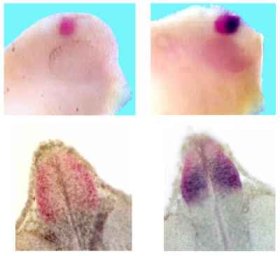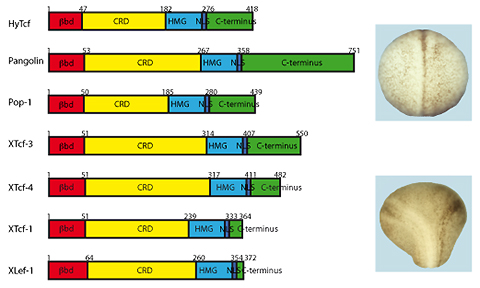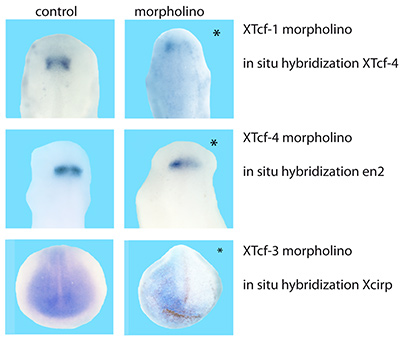Research
Lef/Tcf transcription factors are the nuclear mediators of canonical wnt signaling. They play an important role in many developmental decisions including axis formation, limb bud outgrowth and brain patterning. In vertebrates, four members of the protein family are expressed, Tcf-1, Tcf-3, Tcf-4 and Lef-1. Among them Tcf-4 has the most restricted and unique expression pattern. In Xenopus, XTcf-4 is co-expressed with several Xwnts including Xwnt-2b at the anterior midbrain (König et al., 2000).
 |
Fig.1: Co-localization of XTcf-4 and Xwnt-2b in the anterior midbrain. Transversal sections through the midbrain region of double stained Xenopus tailbuds reveals that both, XTcf-4 (red) and Xwnt-2b (blue) are expressed at in the anterior dorsal midbrain. |
Regulation of Wnt signalling by Lef/Tcf transcription factors
Although the overall structure of Lef/Tcf transcription factors is similar, they exhibit distinct and non-redundant functions. Some of them induce a secondary axis, when injected in the ventral blastomeres of Xenopus 4-cell stage embryos, others inhibit the formation oft he endogenous axis following dorsal injections.
 |
Fig.2: All Lef/Tcf transcription factors, including those of the invertebrate species Hydra (HyTcf), Drosophila (Pangolin) and Caenorhabditis (Pop-1) share a common overall structure which consists of an N-terminal ß-Catenin binding domain (ßbd), a context dependent regulatory domain (CRD) a high mobility group box (HMG) followed by a nuclear localization signal (NLS) and a C-terminal domain. While Lef-1 and Tcf-1 induce a secondary axis upon ventral injection, invertebrate Tcfs do not induce such an axis. |
More specifically, knock-down of individual family members by antisense morpholino injections revealed that XTcf-1, XTcf-3 and XTcf-4 regulate different aspects of CNS development. XTcf-3 is important for early neural fate. It is essential for the expression of the RNA binding protein cirp in the neural plate. XTcf-1 is necessary for the expression of XTcf-4, which in turn is a key regulator for the expression of midbrain and midhindbrain specific marker genes, including en-2
 |
Fig.3: Unilateral injection of antisense morpholino oligonucleotides (marked by an asterisk) revealed the XTcf-1 is essential for XTcf-4 expression, XTcf-4 regulates en2 expression and XTcf-3 is specifically important for Xcirp expression.
|
We take advantage of these very specific and non-redundant functions to identify novel modules and binding partners which are responsible for regulating the transcriptional response to Wnt pathway activation.
Publications
2014-2010
- Wallkamm, V., Dörlich, R., Rahm, K., Klessing, T., Nienhaus, G.U., Wedlich, D., Gradl, D. (2014). Live imaging of Xwnt5A-ROR2 complexes. PlosOne, accepted
- Schmitt, M., Metzger, M., Gradl, D., Davidson, G., Orian-Rousseau, V. (2014). CD44 regulates the Wnt pathway at the level of LRP6. Cell Death Differ, doi: 10.1038/cdd.2014.156. [Epub ahead of print].
- Kumar, S., Žigman, M., Patel, T.R., Trageser, B., Gross, J. C., Rahm, K., Boutros, M., Gradl, D., Steinbeisser, H., Holstein, T., Stetefeld, J. and Özbek, S. (2014). Molecular dissection of Wnt3a-Frizzled8 interaction reveals essential and modulatory determinants of wnt signaling activity. BMC Biol. 12:44.
- Tumova, L., Pombinho, A.R., Vojtechova, M., Stancikova, J., Gradl, D., Krausova, M., Sloncova, E., Horazna, M., Kriz., V., Machonova, O., Jindrich, J., Zdrahal, Z., Bartunek, P., Korinek, V. (2014). Monensin Inhibits Canonical Wnt Signaling in Human Colorectal Cancer Cells and Suppresses Tumor Growth in Multiple Intestinal Neoplasia Mice. Mol. Cancer Ther. 3(4):812-822.
- Schneider, M., Huang, C., Becker, S.F., Gradl, D., Wedlich, D.(2014).The protocadherin PAPC is expressed in the CNC and can compensate for the loss of PCNS. Genesis 52(2):120-126.
- Hedde, P.N., Dörlich, R.M., Blomley, R., Gradl, D., Oppong, E., Cato, A.C.B. and Nienhaus, G.U. (2013). Stimulated Emission Depletion-Based Raster Image Correlation Spectroscopy (STED-RICS) – A Versatile Method for Studying Biomolecular Dynamics in Live Cells. Nature Comm. Jun 27;4:2093.
- Crosta, N., Müller, S., Gradl, D., Masters, K.-S. and Bräse, S. (2013). Rediscovering the Double Friedel-Crafts Acylation: An Expedient Entry to Phenanthrene-9,10-diones. Synlett 24(8): 951-954. DOI: 10.1055/s-0032-1318481.
- Halbedl, S., Kratzer, M.-C. Rahm, K., Crosta, N. Masters, K.-C. Zippert, J., Bräse, S. and Gradl, D. (2013). Synthesis of novel inhibitors blocking Wnt signaling downstream of b-Catenin. FEBS Lett. 587(5), 522-527.
- Horn, E.R., El-Yamany, N.A. and Gradl, D. (2013). The vestibuloocular reflex of tadpoles (Xenopus laevis) after knock-down of the isthmus related transcription factor XTcf-4.J Exp Biol.216(Pt 4), 733-741.
- Kim, C., Kreppenhofer, K., Kashef, J., Gradl, D., Herrmann, D., Schneider, M., Ahrens, R., Guber, A. and Wedlich, D. (2012). Diffusion- and convection-based activation of Wnt/β-catenin signaling in a gradient generating microfluidic chip. Lab Chip, 12(24):5186-5194.
- Klingel, S., Morath, I., Strietz, J., Menzel, K., Holstein, T.W., Gradl, D. (2012). Subfunctionalization and neofunctionalization of vertebrate Lef/Tcf transcription factors. Dev Biol. 368(1), 44-53.
- Holzer, T., Liffers, K., Rahm, K., Trageser, B., Ozbek, S., Gradl, D. (2012). Live imaging of active fluorophore labelled Wnt proteins. FEBS Lett. 586(11), 1638-1644.
- Waaler, J., Machon, O., Tumova, L., Dinh, H., Korinek, V., Wilson, S.R., Paulsen, J.E., Pedersen, N.M., Eide, T.J., Machonova, O., Gradl, D., Voronkov, A., von Kries, J.P., Krauss, S. (2012). A novel tankyrase inhibitor decreases canonical Wnt signaling in colon carcinoma cells and reduces tumor growth in conditional APC mutant mice. Cancer Res. 72(11), 2822-2832.
- Doubravska , L., Krausova, M., Gradl, D. Vojtechova, M., Tumova, A., Lukas, J., Valenta, T., Pospichalova, V., Fafilek, B., Plachy, J., Sebesta, O. and Korinek, V. (2011) Fatty acid modification of Wnt1 and Wnt3a at serine is prerequisite for lipidation at cysteine and is essential for Wnt signalling. Cell Signal. 23(5):837-48.
- Waaler, J., Machon, O., von Kries, J.P., Wilson, S.R., Lundenes, E., Wedlich, D., Gradl, D., Paulsen, J.E., Machonova, O., Dembinski, J.L., Dinah, H. and Krauss S. (2011). Novel Synthetic Antagonists of Canonical Wnt Signaling Inhibit Colorectal Cancer Cell Growth. Cancer Res. 71(1), 197-205.
- Koenig, S.F., Brentle, S., Hamdi, K., Fichtner, D., Wedlich, D. and Gradl, D. (2010). En2. Pax2/5 and Tcf-4 transcription factors cooperate in patterning the Xenopus brain. Dev. Biol. 340, 318-328.
2009-2004
- Herrmann M, Neuberth N, Wissler J, Pérez J, Gradl D, Naber A. (2009). Near-field optical study of protein transport kinetics at a single nuclear pore. Nano Lett. 9, 3330-3336.
- van Venrooy S., Fichtner D., Kunz M., Wedlich D., Gradl D. (2008). Cold-inducible RNA binding protein (CIRP), a novel XTcf-3 specific target gene regulates neural development in Xenopus. BMC Dev Biol. 8:77
- Koenig, S.F., Lattanzio, R. Mansperger, K, Rupp, R.A.W., Wedlich, D. and Gradl, D. (2008). Autoregulation of XTcf-4 depends on a Lef/Tcf site on the XTcf-4 promoter. Genesis, 46, 81-86.
- Bryja, V., Gradl, D., Schambony, A., Arenas. E., and Schulte, G. (2007). β-arrestin is a necessary component of wnt/β-catenin signalling in vitro and in vivo. Proc.Natl.Acad.Sci USA 104, 6690-6695.
- Pukrop, T., Klemm, F., Hagemann, T., Gradl, D., Schulz, M., Siemes, S., Trümper, L., and Binder, C. (2006). Wnt 5a signaling is critical for macrophage-induced invasion of breast cancer cell lines. Proc.Natl.Acad.Sci USA 103, 5454-5459.
- Ghogomu, S., van Venrooy, S., Ritthaler, M., Wedlich, D. and Gradl D. (2006). Hic-5 a novel regulator of Lef/Tcf activity modulates the crosstalk between Wnt-signalling and steroid receptor activity. J. Biol. Chem. 281, 1755-1764.
- Winkler, C., Eggert, C., Gradl, D., Meister, G., Giegerich, M., Wedlich, D., Laggerbauer, B. and Fischer, U. (2005). Reduced production of spliceosomal U snRNPs as a major cause of cell death in SMN deficient cells. Genes Dev. 19, 2320-2330.
- Etard, C., Gradl, D., Kunz, M., Eilers, M. and Wedlich, D. (2005). Pontin and Reptin regulate cell proliferation in early Xenopus embryos in collaboration with c-Myc and Miz-1. Mech. Develop. 122, 545-556.
- Schambony, A., Kunz M. and Gradl, D. (2004). Cross-regulation of Wnt-signalling and cell adhesion. Differentiation. 72, 307-318.
- Kunz, M., Herrmann, M., Wedlich, D. and Gradl, D. (2004). Autoregulation of canonical Wnt signaling controls midbrain development. Dev. Biol. 273, 390-341.
< 2004
- Gradl, D., König, A. and Wedlich, D. (2002). Secondary axis formation by LEF/TCF transcription factors depends on the presence of an activating element which is flanked by two repressing motifs. J. Biol. Chem. 277, 14159-14171.
- Gradl, D. and Wedlich, D. (2002). The nuclear endpoint of the oncogenic Wnt/ß-catenin pathway: How to achieve specificity. Signpost reviews, Recent Research Developments in Molecular & Cellular Biology, S.G. Pandalai, Editor.
- Pukrop, T., Gradl, D., Heningfield, K., Knöchel, W., Wedlich, D. and Kühl, M. (2001). Identification of two regulatory elements within the high mobility group box transcription factor XTCF-4. J. Biol. Chem. 276, 8968-8978.
- König, A., Gradl, D., Kühl, M. and Wedlich, D. (2000). The HMG-box transcription factor XTcf-4 demarcates the forebrain-midbrain boundary. Mech. Develop. 93, 211-214.
- Gradl, D., Kühl, M. and Wedlich, D. (1999). The Wnt/wg signal transducer ß-catenin controls fibronectin expression. Mol. Cell Biol. 19, 5576-5587.
- Gradl, D., Kühl, M. and Wedlich, D. (1999). Keeping a close eye on Wnt-1/wg signaling in Xenopus. Mech. Develop. 86, 3-15.
People
 |
|
|
|
Jessica Zippert
|
|
Karolin Rahm (Techn. Assistant) and formerly Dr. Susanne Klingel, Kaga Gomarteli (Graduant), Julia Zeisluft (Apprentice)


